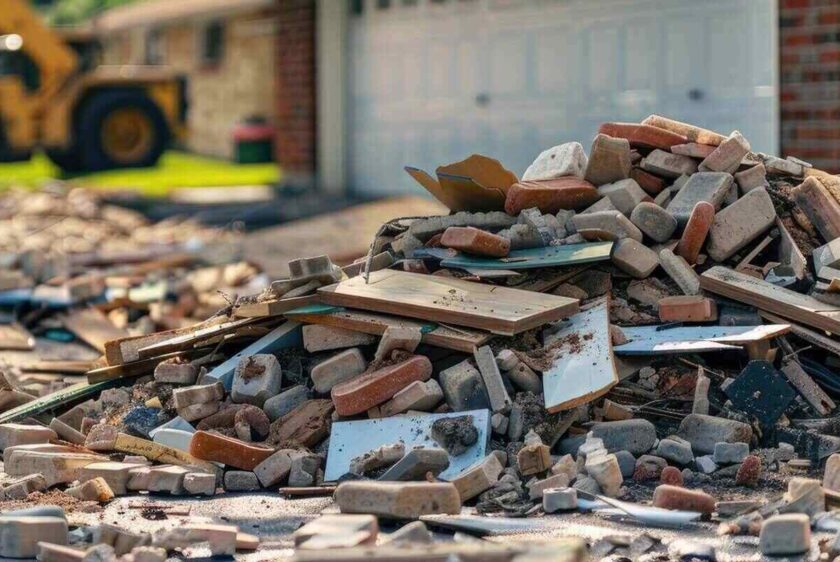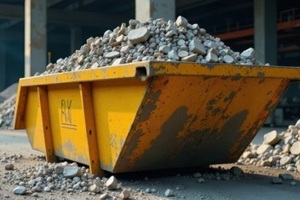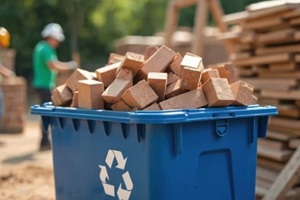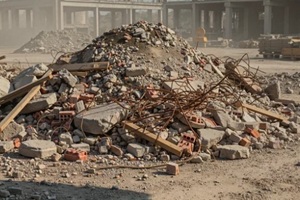
Key Safety Tips for Managing Construction Debris
Construction sites can accumulate a large amount of waste, and without proper waste management strategies, this debris can become a costly challenge. According to the EPA, around 600 million tons of construction debris are accumulated every year, which is why so many municipal, state, and federal codes exist to control its safe management.
More than just giving information on managing construction debris, this blog focuses on tips for safe and effective waste management. Improper management can lead not only to dangerous construction sites but also to legal repercussions due to waste disposal code violations. Minimizing these costly challenges begins with adopting better safety practices for construction waste management.
What Is Construction Debris and How Does It Differ from Waste?

Construction debris or construction waste is defined by the terms of each state’s waste management codes. According to the Virginia Waste Management Board, “construction waste” is used to describe any solid waste produced through the process of constructing, remodeling, or repairing homes, commercial buildings, and other structures.
Despite this definition, not all waste produced by construction projects is considered construction debris. It is the responsibility of the construction companies to recognize the difference between legitimate debris and other types of waste to keep their operations compliant and safe.
For example, while structural materials like lumber, wire, shingles, and sheetrock are considered construction debris, liquid, chemical, and gaseous materials are considered hazardous waste. Hazardous waste includes aerosols, paints, coatings, solvents, asbestos, mercury, and more. These materials require special transport, storage, and disposal procedures at designated facilities.
Safe management of construction debris requires recognizing the difference between debris and hazardous waste materials. Mixing masonry, demolition waste, and hazardous chemicals in the same piles for disposal can be disastrous, not only for the reputation of the construction company but also for the safety of the surrounding environment.
What are the Risks of Improper Construction Debris Disposal?
When improperly disposed of, construction debris can cause significant negative effects on the surrounding environment, local public safety, and the health of construction workers. These are just a few of the most common risks associated with improper waste management:
- Chemical Exposure: Workers, homeowners, and others can be exposed to dangerous chemicals if they are improperly handled and removed, which can lead to cancer, respiratory illnesses, and other long-term health issues.
- Accidents and Injuries: Large accumulations of unsecured construction debris, even when dealing with normally non-hazardous materials, can cause accidents if improperly managed. Large stockpiles can cause accidents that injure workers or pedestrians, block public roads, or cause fires.
- Environmental Pollution: Improper debris disposal can cause environmental pollution. This includes air pollution in the case of hazardous gaseous chemicals, as well as water and soil pollution if contamination and runoff leak into local water sources.
In addition to these safety risks, construction companies risk regulatory non-compliance by failing to safely manage construction waste. This can result in large fines, reputational damage, or even jail time if the offenses are severe enough.
How Should Companies Manage Construction Debris?

To avoid safety violations, environmental damage, worker injuries, and legal repercussions, construction companies should follow these safety tips for managing project debris:
- Accurate Planning: Materials should be identified and classified as the cleanup procedures are planned. Making a detailed plan will reduce safety mistakes.
- Sustainable Materials: Choosing sustainable and recyclable materials to begin with can help safely manage the resulting construction debris.
- Recycling Process: Setting up recycling bins and alerting local recycling plants before starting the project can simplify the process.
- Minimize Waste: Companies can minimize construction debris by measuring, cutting, and handling materials more carefully. This includes properly storing materials to prevent damage that leads to more waste.
- Maintaining Equipment: Properly maintained equipment and PPE help workers safely complete projects and efficiently handle material waste.
- Donation Workflow: Construction owners should establish donation funnels to local salvage yards, reuse centers, recycling plants, or charities. Depending on the quality and type of material, it can be put to good use.
- Recognizing Hazards: Many hazardous waste materials require trained waste disposal experts working with the proper facilities. Recognizing when specialized expertise is needed will help prevent worker injury and environmental damage.
- Following Regulations: Municipal, state, and federal codes govern proper construction waste disposal. These codes must be acknowledged and followed to remove, transport, store, and eliminate materials safely.
- Collaborating with Experts: Local waste management teams familiar with local codes, reuse plants, and landfills help construction companies properly organize and dispose of construction debris. These experts provide teams educated and trained in safe waste management procedures for their area, allowing construction companies to focus on keeping their workers and clients safe.
Consulting with a waste expert in the planning stages can prevent unexpected and undesirable setbacks later.
Partner with Waste Disposal Experts to Safely Manage Construction Debris

At Full Strut Disposal, our waste management team helps construction companies and contractors safely manage their construction debris. As a local company, we know the relevant safety codes for the Virginia Beach area, including state and federal waste disposal regulations. We help companies identify, categorize, transport, and properly dispose of construction waste, according to the procedures required for each type of material.
Contact our team today to learn how our detailed planning methods and on-site waste management process can help safely manage construction waste, regardless of the size or nature of the project.
"*" indicates required fields



